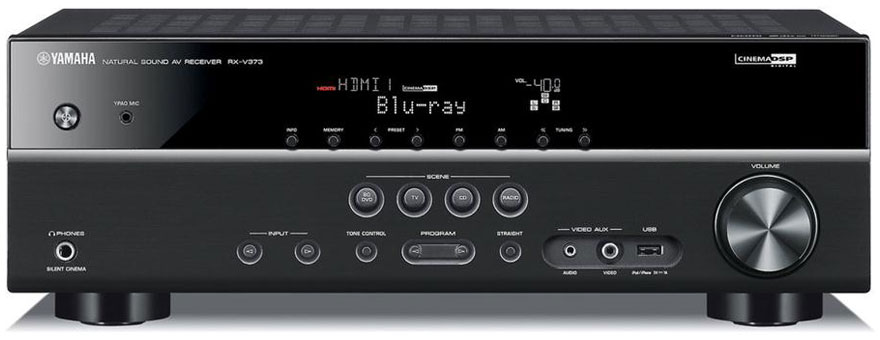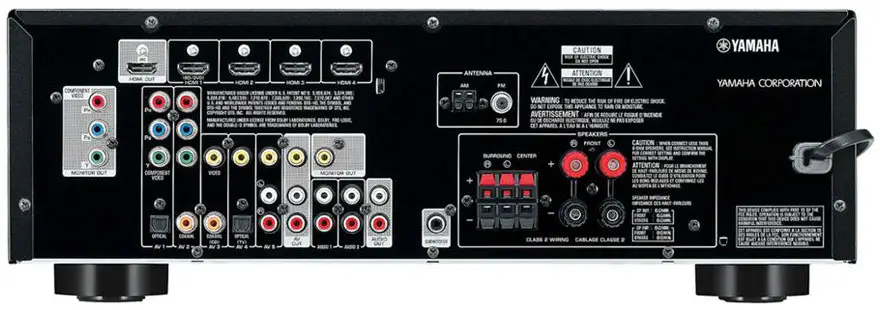The Yamaha RX-V373 is out to prove that a feature-rich AV receiver can dip below the $400 mark. But the many budget AV receivers that strived to do this in the past had to make some compromises by offering some half-baked features that didn’t really impress customers. The $250 Yamaha RX-V371 model is part of an older generation of Yamaha AV receivers but the features are far more basic. The RX-V373 reveals some interesting features that you would normally find on a high-end model.
Design and Connectivity
Yamaha hasn’t really innovated all that much in the design department but it might not need to because there are a lot of customers that are used to the design of Yamaha AV receivers. The four familiar circular SCENE buttons are found on the center of the player along with the other controls that you would normally expect from an AV receiver. Being an entry-level model, you cannot plug much on the front of the player. There is a phones jack on the left and the video aux and USB port found on the right. The rest of the ports are found on the back of the AV receiver including 4 HDMI inputs and a single HDMI output.
Below is the back panel layout. Click on image to enlarge for a clearer view.
Features
4K pass-through is one of the most surprising features ever added on an entry-level model because the display market is still dominated with 1080p TVs. There are very few TVs that are capable of 4K which is basically 4 times the resolution of a 1080p resolution. Some of the largest displays have it and they are not really commercially available. Once the technology is more affordable, the Yamaha RX-V373 is ready to pass any 4K data from a 4K compatible video source to the display.
The receiver is also capable of handling 3D signal data via HDMI. This means that you can plug in any 3D Blu-ray player and 3D HDTV to the AV receiver so you can enjoy the latest 3D content at optimal performance. The latest HDMI specification also features the Audio Return Channel so you won’t need an optical cable just to hear any sound coming from the display.
The RX-V373 supports 5.1-channel configurations which are fairly common these days because of their affordability. A number of audio formats can take advantage of these configurations including Dolby TrueHD, DTS-HD Master Audio, DTS-HD High Resolution Audio and DTS-HD. This sums up the RX-V373′s support for CINEMA DSP which is good for watching movies.
The speakers need to be set up properly in order to notice the decent audio quality. Fortunately, setup is easy thanks to YPAO or Yamaha Parametric Room Acoustic Optimizer which is a special sound optimization feature that makes use of a small microphone that is included in the package. This microphone is a calibration unit that is used to calibrate the speakers. Any noise that is picked up by the microphone is analyzed and used to determine the best parameters for every speaker. This allows the Yamaha RX-V373 to easily adapt to different room configurations.
Once the calibration is completed, the next big step is to plug the various home theater components into the HDMI ports. These four HDMI ports are tied to the SCENE buttons found on the front of the player. This allows for easy switching to other input sources. The Yamaha RX-V373 also gives you the option to reassign any of the SCENE buttons to another source.
The Yamaha RX-V373 is quite strong in audio features thanks to a number of features that can improve any 5.1-speaker system connected to the RX-V373. The sound imaging can be improved if you utilize the Subwoofer Trim control. This technology works by enhancing any low frequencies in such a way that front speaker outputs do not overlap. Adaptive DRC or Dynamic Range Control does a nice job in adjusting the sound levels so it is possible to hear all forms of sound effects from those faint whispers to huge explosions. This feature can also be handy if you are tired of being overwhelmed with those surprise TV commercials that have a very high volume. Silent Cinema technology also makes a return by giving any pair of headphones connected to the AV receiver that nice boost of surround sound.
The USB port that is found on the front of the AV receiver allows any iPod and iPhone models to be hooked up so you can play back any audio tracks stored there. You do not have to be close to the iPod or iPhone because the remote control that comes with the Yamaha package can be used to control the connected device. To improve the audio quality even more, the Compressed Music Enhancer can be used to restore any missing data on a track.
Finally, the Yamaha RX-V373 is very friendly to the environment as there is an ECO mode that can reduce the power consumption by as much 20 percent. You can even save more energy by telling the Yamaha RX-V373 to power down automatically after a period of 2, 4, 8 or 12 hours. When on standby mode, the RX-V373 only consumes 0.3 watts.
Conclusion
There is no way to test if the 4k features are really that great but there is actually no need to test it because the technology is still very young. But that doesn’t make the Yamaha RX-V373 anything less than amazing because it is futureproof. Not many AV receivers support 4k to begin with and it doesnít look like there will be much support this 2012. But once there are big 4k HDTVs that are more affordable, the Yamaha RX-V373 can be ready to put the TV to the test on the highest possible resolution. The price sounds very tempting and the performance is just good enough for watching ordinary TV along with the occasional Blu-ray disc. One of the main reasons to consider a higher end model is if you want a larger number of HDMI ports. Compared to the competition, the $250 price tag is hard to beat for what you get.


